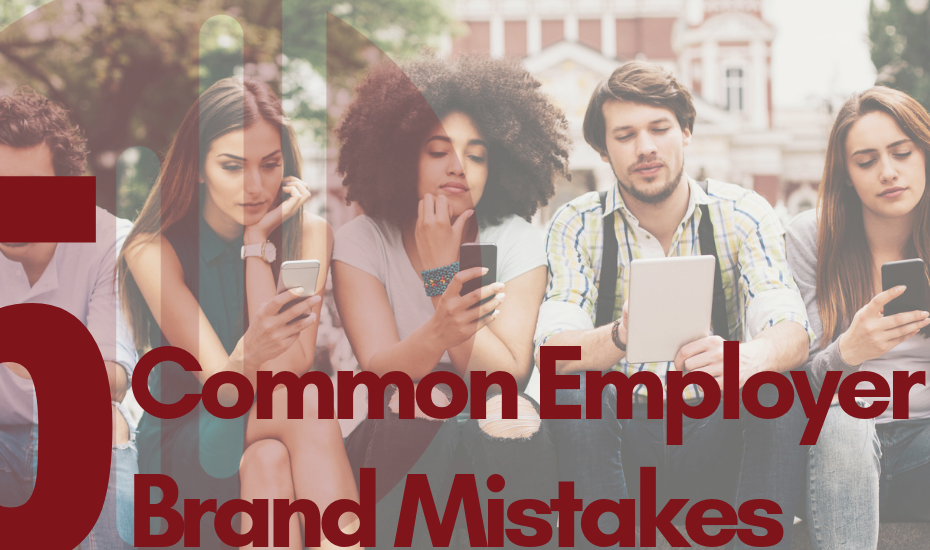How much does your employer brand matter? The simple answer: a lot. You have seen the headlines. You’ve read the articles. You have probably even seen the stats.
According to a recent study, 84% of employees would think about leaving their job if they got an offer at a company with a great reputation. That’s a big percentage! Good employer branding builds your reputation and gets your employees on board, so that they want to tell their friends about how great it is to work for you. It makes you attractive to your ideal candidates. It makes your company one that that 84% of employees would consider leaving their current jobs for.
Here are 5 ways you’re letting your employer brand down:
1. Forgetting Your Audience

If you want to miss the mark, don’t take the time to listen to your people. An effective employer brand is authentic and honest. It reflects your employees, and what they want. It defines an employee experience that is personal, and that your people feel good about getting behind.
Neglecting to understand your audience — the people who work for you, and who you want working for you — will make your message ring hollow, no matter how good it sounds. Play fast and loose with your reputation by telling your people what they should think about your organization, rather than listening to what they actually think.
Listening to your people is a key first step in building employer brand ambassadors. Employees are the greatest amplifiers of your employer brand. Get them onside and reassure them that you care about their experiences and ideas.
Engage your people in meaningful conversations about what working for your company means to them, and create a message that will resonate.
2. Expecting Immediate Results

According to Brett Michington of Employer Brand International, “Companies transition towards a strategic approach to employer brand management after two to three years of adopting the concept.” In other words, it takes time to implement, test and refine a good employer branding strategy.
Building an effective employer brand takes time. Look beyond the immediate ROI, testing to see what’s working and what’s not. Gather and interpret data to implement improvements to your strategy.
Michington says that employer branding is much bigger than a stand-alone recruiting function. Implemented effectively, an employer brand can result in transformational results. Some great examples including industry-leaders like L’Oréal, Sodexo and UnitedHealth Group. These organizations are now seeing the benefits of their investments in employer branding over the past 5-10 years.
3. Not Measuring Results

In order to see whether something is working or not, you have to measure results. Employer branding is the same. As long as you don’t know what impact your employer branding strategy is having on your business, you won’t be able to adapt or evolve that strategy.
To determine which metrics are relevant for you, start by understanding the goals that motivated you to invest in your employer brand. ERE media has listed some metrics that you could measure: how well new hires are performing, whether or not overall productivity is increasing, whether new hires in revenue-generating positions are bringing in more revenue, whether your retention rate has increased, and many more.
While employer branding is a long-term play, you should measure the results of your efforts to best evolve your strategy.
4. Lacking Leadership

When an organization decides to focus resources on their employer branding, there is often a lot of confusion about who should be in charge. Should it be HR? Marketing? Senior leadership? Should the responsibilities be spread around?
There is no one right answer. A number of factors play a role in who should drive and champion employer branding in your organization, including your size and organizational structure. It is likely that many people and departments will – and should – be involved. To best optimize the results of your employer branding efforts, be sure to appoint a clear champion.
Without a clear champion, the potential confusion about roles and responsibilities will hinder even the best employer brand, and could even derail it entirely.
5. Misusing Social Media

79% of job seekers use social media in their job search. Want to prevent job seekers from learning about your company? Or from considering you as a potential employer? Stay away from social media!
Try to learn how your employees and ideal candidates use social media channels like Facebook, LinkedIn, Twitter, YouTube and Instagram, and to understand how you can reach them on those channels. Then show off your company culture by posting photos, videos, and other information to showcase what it’s really like to work with you.
Avoid using your social media as a job board, posting generic job descriptions for job openings. Instead, focus on cultivating and sharing topical content that your people care about.
If you’d rather be helping your employer brand than letting it down, let’s chat.
[cv_button text=”Get in Touch!” url=”http://envolstrategies.com/#contact” size=”medium” style=”filled” color=”custom” custom_color=”#7f141b” icon_position=”none” icon=”mail-1″]
Brianna Blaney, Managing Partner
[email protected]
P: +1 778.650.0090 ext. 106
LinkedIn | Twitter
